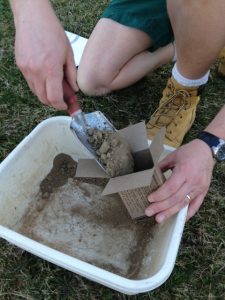Sweet Corn IPM Newsletter No. 11- September 10, 2021
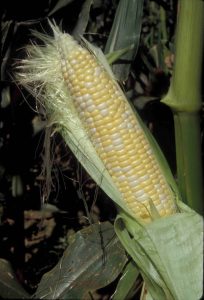
Sweet Corn IPM Newsletter No. 11- September 10, 2021
Click on photos to enlarge.
LATE SEASON CORN EARWORM THREAT
A Protective Schedule for Corn Earworm Needed on Any Silking Corn Remaining
SITUATION
Many farms are nearing the end of their sweet corn harvest, the summer heat has condensed maturity time for late planted corn. Earworm and fall armyworm numbers were high enough to keep most farms on a regular spray schedule, but some fields have no fresh silking corn remaining, and have seen a downturn in moth activity. Next week’s issue of the Sweet Corn IPM Newsletter will be the last one scheduled for this season .
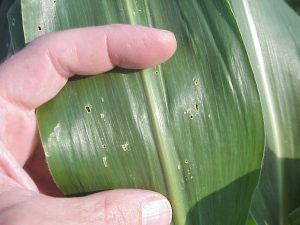
European corn borer:
No fields were over the 15% control threshold for larval feeding activity this week, and no moths were found in pheromone traps.
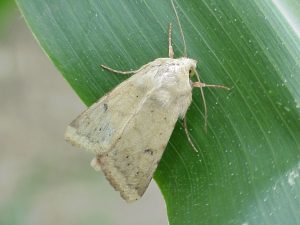
Corn earworm:
Pheromone trap moth captures were higher in most sites this week, although some sites had none, usually where there was no fresh silking corn remaining. A 4-day spray schedule was recommended for fresh silking corn in: Auburn, Biddeford, Bowdoinham, Cape Elizabeth, Corinth, New Gloucester and one Dayton site. A 5-day spray schedule was recommended for: Oxford, Wayne and one Dayton site. A 6-day spray interval was recommended for one Wells site. Spraying should be halted once silks are dried, about 5 to 7 days before harvest.
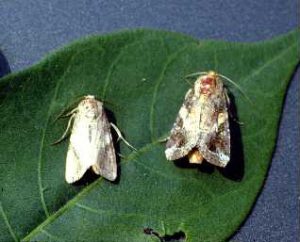
Fall armyworm:
Moths counts were high enough to warrant protection of silking corn at most locations, including: Auburn, Biddeford, Bowdoinham, Cape Elizabeth, Corinth, Dayton, Monmouth, New Gloucester and Sabattus. Except for Monmouth and Sabattus, all sites are on a recommended spray schedule for corn earworm, which should provide protection against fall armyworm.
- Corn Field Plowed Down; photo by David Handley
- Soil Sample Collection, photo by David Handley
- Oats Cover Crop; photo by David Handley
Annual end of corn season checklist:
- Plow down corn stalks and stubble to destroy overwintering larvae of European corn borer
- Plant a cover crop, such as winter rye, to prevent soil erosion and to add organic matter to the soil.
- Take a soil test to determine if lime or other nutrients should be applied.
- Plan to rotate your crops to prevent pests from building up in any one location.
- Evaluate your weed management results. What worked well and what didn’t? Which weeds were the biggest problems? How can you improve control?
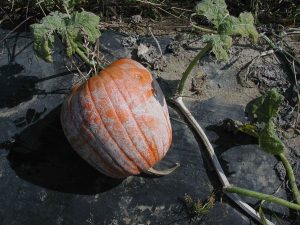
Plectosporium blight of pumpkin and winter squash:
More infected fields have been reported this week. This fungus disease causes white flecking in the surface of the fruit and leaves, leading to collapse of the plants and fruit rot. See the New England Vegetable Management Guide for details. The fungicides Quadris®, Maneb®, Bravo®, Cabrio® and Flint® are registered to control Plectosporium.
The New England Vegetable & Fruit Conference will be held virtually this year, December 13 – December 17, 2021. Program and registration information will be coming soon. Visit the website. We hope to return to an in person conference in December of 2022.
Sincerely,
David T. Handley
Vegetable and Small Fruit Specialist
Highmoor Farm Pest Management Unit
P.O. Box 179 17 Godfrey Drive
52 U.S. Route 202 Orono, ME 04473
Monmouth, ME 04259
207.933.2100 1.800.287.0279

| Location | CEW
Moths |
ECB
Moths |
FAW
Moths |
%Feeding
Damage |
Recommendations / Comments |
|---|---|---|---|---|---|
| Auburn | 9 | 0 | 8 | 4-day spray interval for silking corn | |
| Biddeford | 13 | 0 | 17 | 4-day spray interval for silking corn | |
| Bowdoinham | 14 | 0 | 4 | 4-day spray interval for silking corn | |
| Cape Elizabeth | 23 | 0 | 3 | 4-day spray interval for silking corn | |
| Corinth | 9 | 0 | 7 | 0% | 4-day spray interval for silking corn |
| Dayton I | 20 | 0 | 8 | 4-day spray interval for silking corn | |
| Dayton II | 7 | 0 | 7 | 5-day spray interval for silking corn | |
| Monmouth | 0 | 0 | 10 | One spray for FAW on all silking corn | |
| New Gloucester | 15 | 0 | 9 | 4-day spray interval for silking corn | |
| Oxford | 4 | 0 | 1 | 5-day spray interval for silking corn | |
| Sabattus | 0 | 0 | 6 | One spray for FAW on all silking corn | |
| Wayne | 4 | 0 | 0 | 5-day spray interval for silking corn | |
| Wells I | 0 | 0 | 0 | No spray recommended | |
| Wells II | 2 | 0 | 1 | 6-day spray interval for silking corn |
CEW: Corn earworm (Only fresh silking corn should be sprayed for this insect.)
ECB: European corn borer
FAW: Fall armyworm
| Moths caught per week | Moths caught per night | Spray interval |
|---|---|---|
| 0.0 to 1.4 | 0.0 to 0.2 | No spray |
| 1.5 to 3.5 | 0.3 to 0.5 | Spray every 6 days |
| 3.6 to 7.0 | 0.6 to 1.0 | Spray every 5 days |
| 7.1 to 91 | 1.1 to 13.0 | Spray every 4 days |
| More than 91 | More than 13 | Spray every 3 days |
Thresholds apply only to corn with exposed fresh silk. Lengthen spray intervals by one day if maximum daily temperature is less than 80°F.
European Corn Borer Thresholds
Whorl stage: 30% or more of plants scouted show injury.
Pre-tassel-silk: 15% or more of plants scouted show injury.
Silk: 5 or more moths caught in pheromone traps in one week.
IPM Web Pages:
Where brand names or company names are used, it is for the reader’s information. No endorsement is implied nor is any discrimination intended against other products with similar ingredients. Always consult product labels for rates, application instructions and safety precautions. Users of these products assume all associated risks.
The University of Maine is an equal opportunity/affirmative action institution.


